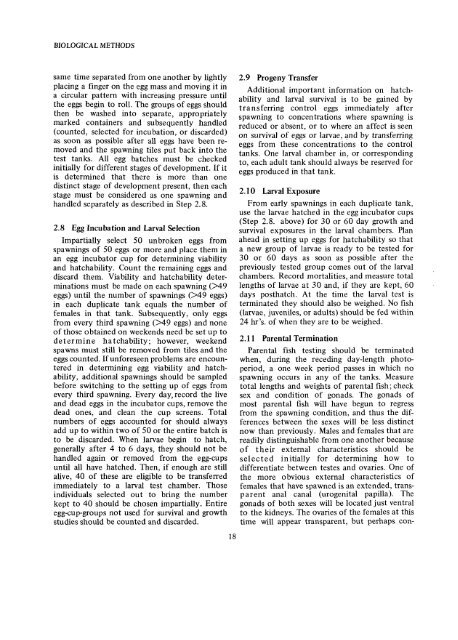Biological field and laboratory methods for measuring the quality of ...
Biological field and laboratory methods for measuring the quality of ...
Biological field and laboratory methods for measuring the quality of ...
Create successful ePaper yourself
Turn your PDF publications into a flip-book with our unique Google optimized e-Paper software.
BIOLOGICAL METHODS<br />
same time separated from one ano<strong>the</strong>r by lightly<br />
placing a finger on <strong>the</strong> egg mass <strong>and</strong> moving it in<br />
a circular pattern with increasing pressure until<br />
<strong>the</strong> eggs begin to roll. The groups <strong>of</strong> eggs should<br />
<strong>the</strong>n be washed into separate, appropriately<br />
marked containers <strong>and</strong> subsequently h<strong>and</strong>led<br />
(counted, selected <strong>for</strong> incubation, or discarded)<br />
as soon as possible after all eggs have been removed<br />
<strong>and</strong> <strong>the</strong> spawning tiles put back into <strong>the</strong><br />
test tanks. All egg batches must be checked<br />
initially <strong>for</strong> different stages <strong>of</strong> development. If it<br />
is determined that <strong>the</strong>re is more than one<br />
distinct stage <strong>of</strong> development present, <strong>the</strong>n each<br />
stage must be considered as one spawning <strong>and</strong><br />
h<strong>and</strong>led separately as described in Step 2.8.<br />
2.8 Egg Incubation <strong>and</strong> Larval Selection<br />
Impartially select 50 unbroken eggs from<br />
spawnings <strong>of</strong> 50 eggs or more <strong>and</strong> place <strong>the</strong>m in<br />
an egg incubator cup <strong>for</strong> determining viability<br />
<strong>and</strong> hatchability. Count <strong>the</strong> remaining eggs <strong>and</strong><br />
discard <strong>the</strong>m. Viability <strong>and</strong> hatchability determinations<br />
must be made on each spawning (>49<br />
eggs) until <strong>the</strong> number <strong>of</strong> spawnings (>49 eggs)<br />
in each duplicate tank equals <strong>the</strong> number <strong>of</strong><br />
females in that tank. Subsequently, only eggs<br />
from every third spawning (>49 eggs) <strong>and</strong> none<br />
<strong>of</strong> those obtained on weekends need be set up to<br />
determine hatchability; however, weekend<br />
spawns must still be removed from tiles <strong>and</strong> <strong>the</strong><br />
eggs counted. If un<strong>for</strong>eseen problems are encountered<br />
in determining egg viability <strong>and</strong> hatchability,<br />
additional spawnings should be sampled<br />
be<strong>for</strong>e switching to <strong>the</strong> setting up <strong>of</strong> eggs from<br />
every third spawning. Every day, record <strong>the</strong> live<br />
<strong>and</strong> dead eggs in <strong>the</strong> incubator cups, remove <strong>the</strong><br />
dead ones, <strong>and</strong> clean <strong>the</strong> cup screens. Total<br />
numbers <strong>of</strong> eggs accounted <strong>for</strong> should always<br />
add up to within two <strong>of</strong> 50 or <strong>the</strong> entire batch is<br />
to be discarded. When larvae begin to hatch,<br />
generally after 4 to 6 days, <strong>the</strong>y should not be<br />
h<strong>and</strong>led again or removed from <strong>the</strong> egg-cups<br />
until all have hatched. Then, if enough are still<br />
alive, 40 <strong>of</strong> <strong>the</strong>se are eligible to be transferred<br />
immediately to a larval test chamber. Those<br />
individuals selected out to bring <strong>the</strong> number<br />
kept to 40 should be chosen impartially. Entire<br />
egg-cup-groups not used <strong>for</strong> survival <strong>and</strong> growth<br />
studies should be counted <strong>and</strong> discarded.<br />
18<br />
2.9 Progeny Transfer<br />
Additional important in<strong>for</strong>mation on hatchability<br />
<strong>and</strong> larval survival is to be gained by<br />
transferring control eggs immediately after<br />
spawning to concentrations where spawning is<br />
reduced or absent, or to where an affect is seen<br />
on survival <strong>of</strong> eggs or larvae, qnd by transferring<br />
eggs from <strong>the</strong>se concentrations to <strong>the</strong> control<br />
tanks. One larval chamber in, or corresponding<br />
to, each adult tank should always be reserved <strong>for</strong><br />
eggs produced in that tank.<br />
2.10 Larval Exposure<br />
From early spawnings in each duplicate tank,<br />
use <strong>the</strong> larvae hatched in <strong>the</strong> egg incubator cups<br />
(Step 2.8. above) <strong>for</strong> 30 or 60 day growth <strong>and</strong><br />
survival exposures in <strong>the</strong> larval chambers. Plan<br />
ahead in setting up eggs <strong>for</strong> hatchability so that<br />
a new group <strong>of</strong> larvae is ready to be tested <strong>for</strong><br />
30 or 60 days as soon as possible after <strong>the</strong><br />
previously tested group comes out <strong>of</strong> <strong>the</strong> larval<br />
chambers. Record mortalities, <strong>and</strong> measure total<br />
lengths <strong>of</strong> larvae at 30 <strong>and</strong>, if <strong>the</strong>y are kept, 60<br />
days posthatch. At <strong>the</strong> time <strong>the</strong> larval test is<br />
terminated <strong>the</strong>y should also be weighed. No fish<br />
(larvae, juveniles, or adults) should be fed within<br />
24 hr's. <strong>of</strong> when <strong>the</strong>y are to be weighed.<br />
2.11 Parental Termination<br />
Parental fish testing should be terminated<br />
when, during <strong>the</strong> receding day-length photoperiod,<br />
a one week period passes in which no<br />
spawning occurs in any <strong>of</strong> <strong>the</strong> tanks. Measure<br />
total lengths <strong>and</strong> weights <strong>of</strong> parental fish; check<br />
sex <strong>and</strong> condition <strong>of</strong> gonads. The gonads <strong>of</strong><br />
most parental fish will have begun to regress<br />
from <strong>the</strong> spawning condition, <strong>and</strong> thus <strong>the</strong> differences<br />
between <strong>the</strong> sexes will be less distinct<br />
now than previously. Males <strong>and</strong> females that are<br />
readily distinguishable from one ano<strong>the</strong>r because<br />
<strong>of</strong> <strong>the</strong>ir external characteristics should be<br />
selected initially <strong>for</strong> determining how to<br />
differentiate between testes <strong>and</strong> ovaries. One <strong>of</strong><br />
<strong>the</strong> more obvious external characteristics <strong>of</strong><br />
females that have spawned is an extended, transparent<br />
anal canal (urogenital papilla). The<br />
gonads <strong>of</strong> both sexes will be located just ventral<br />
to <strong>the</strong> kidneys. The ovaries <strong>of</strong> <strong>the</strong> females at this<br />
time will appear transparent, but perhaps con-















